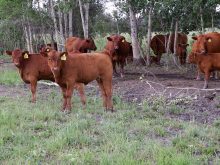Western Producer Calgary reporter Barbara Duckworth attended an invasive plants conference in Calgary and filed these reports.
Misinformation about herbicide use may have contributed to the uncontrolled spread of some noxious weeds in North America.
An American invasive plants specialist said well-meaning people blocked the use of effective herbicides in some areas of the United States that are now overrun with problem plants.
Leafy spurge, with its powerful tap roots, could be taken out with effective herbicides, said Randy Westbrooks at an invasive plants conference held in Calgary Oct. 2-3.
Read Also

August rain welcome, but offered limited relief
Increased precipitation in August aids farmers prior to harvest in southern prairies of Canada.
Chemical compounds ultimately break down, but without controls, troublesome plants like leafy spurge and purple loosestrife do not disappear.
“If we stop selling purple loosestrife in the stores, we will still have purple loosestrife in 100 years,” he said.
Jerry Asher, a retired agent for the U.S. bureau for land management, said some of the most serious infestations of weeds are on public lands.
Invasive species could be removed with fire under careful management.
Typically after a fire the weeds grow back first. Herbicides should be sprayed in these areas before the weeds set seeds. If ignored, they soon take over an area making it difficult for trees and other native plants to return.
Another effective control is releasing armies of wasps and weevils to fight invading plants.
Small in size, these predator insects can be spectacularly effective by doing tremendous damage to weeds plaguing farms, wildlife habitat and water courses.
Because invasive plants came from other places, researchers travel to their country of origin to collect and import their natural enemies, said Alec McClay of the Alberta Research Council.
The aim is to reduce the invaders to an acceptable level or even eradicate them. At the same time authorities must ensure these biological agents do not attack native species.
Researchers must go through several levels of government and regulatory agencies to get all information approved. Every agent is tested extensively before introduction to Canada and may take three to four years of study before release.
For the most part these predators are highly selective and unlike some herbicides, do not leave chemical residues. They can enter hard-to-reach areas and travel long distances.
However, several predators types may be required for one weed and they may not always be the perfect solution.
“It is not a cure-all. It’s a long-term approach. It’s not going to cure anything overnight,” McClay said.
There are success stories.
Tansy ragwort from Europe is a serious problem in British Columbia and the northwestern U.S. It has been controlled by a root weevil from Europe.
Flea beetles feasting on leafy spurge in Alberta and B.C. can reduce these troublesome plants to low densities and allow room for native plants to return.
Dalamation toadflax has received attacks from five different insects in the last 10 years. Each eats a different part of the plant and eventually destroys it.
A couple of different weevils and midges have been turned loose on scentless chamomile in central Alberta.
However releasing insects in the Prairies is sometimes hampered by the short, cool growing season. There may not be enough time for predator insects to complete their growth cycles and take on the weeds effectively.
There is also a question about jurisdiction.
Scientists can find the predators and research their effectiveness, but when they are ready for wide scale release, no one is eager to take over. Someone has to rear and release the insects.
Private enterprise does not see a large enough return in the programs and some government agencies step back because no one is sure whose job it is to handle the predators.















